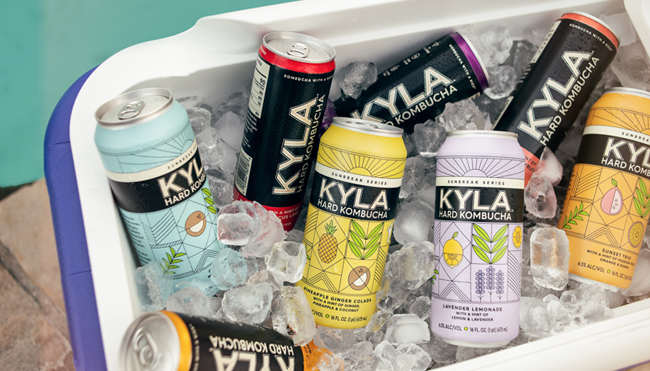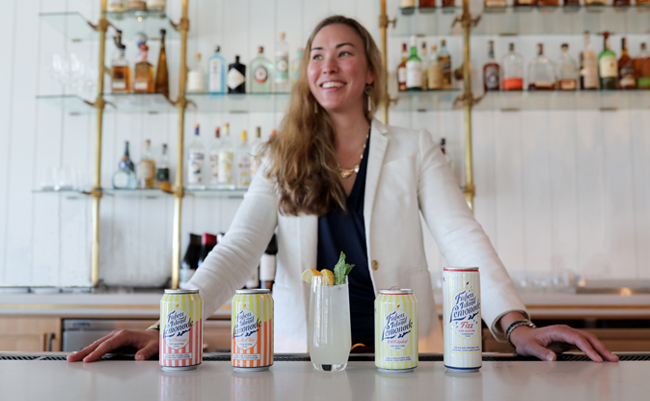Two-thirds of Americans drink alcohol, according to a 2019 Gallup poll. Within this group, those who specify a preference for liquor as their main choice rose from under 20 percent to nearly 30 percent in the last decade. Beer, wine, and spirits are still performing strongly, but their dominant positions continue to waver as demand for alternative beverages like hard seltzers and other ready-to-drink (RTDs) cocktails carry on their stratospheric surges.
RTDs’ share of spirits is rising — annually increasing by double, if not triple, digits over the past few years in off-premise sales, according to Nielsen’s vice president of Beverage Alcohol Practice, Danelle Kosmal. And that means it’s drawing more and more companies to build their own RTD brands to capture a slice of the segment that’s estimated to exceed a billion dollars by 2027, according to Grand View Research, Inc.
Some of this rise can be attributed to the pandemic, which decimated on-premise imbibing; some can be attributed to consumers opting for more single-serving options, like individual cans, instead of bottles that are meant to be shared. Alcohol e-commerce platform Drizly projects the RTD category will “grow at a 11.5 percent compound annual growth rate between 2019 and 2024,” regardless of COVID-19’s effect on consumer purchasing habits.
With projections predicting continued segment growth for RTDs, anyone looking to enter the space will face a competitive landscape. But by studying brands who have either launched during the pandemic or have weathered the storm without faltering, there are plenty of opportunities for new premixed canned cocktails to thrive.
Which Brands Have Thrived Since Launching
Smaller brands like CANTEEN Spirits and Fishers Island Lemonade have seen tremendous growth since launching in 2019 and 2014, and several global conglomerates have either started or acquired brands within the RTD space. AB InBev purchased Cutwater Spirits in 2019, and even a few of their subsidiaries are getting in on the RTD action. In 2020, Labatt Breweries of Canada bought Goodridge & Williams, with Brewbound quoting Labatt president as expressing the company’s motivation to add RTDs to their portfolio due to the explosive growth of the RTD category as a whole. Drizly also identifies major spirits brands like Absolut, Tanqueray, and Malibu as having launched products that have proven to be big contenders in the canned cocktail space.
Despite a number of Goliaths already positioned within the RTD space, there remains plenty of room for Davids who wish to enter the arena. In 2020, Drizly’s top-selling RTD brands were High Noon, Ranch Rider Spirits, and Fishers Island Lemonade. Earning the top sales status is a monumental achievement, considering the number of RTD brands available for purchase on Drizly went from 85 brands in 2019 to 168 brands in 2020, with High Noon capturing 55 percent of RTD market share (up from 13 percent in 2019).
Drizly hypothesizes some of High Noon’s success comes from the fact its base is vodka, despite being marketed as a hard seltzer with a vodka base. Thanks to formerly hard-line definitions between categories becoming more blurred by the day, this type of crossover bodes well for RTDs that fit more than one segment’s criteria. But when it comes to successfully launching — and maintaining — an RTD brand, there’s more to consider than just the base spirit itself.
Providing Better-For-You Options
“New brands should understand their supply chain and the market gap they’re trying to fill,” says Mark Anderson, founder and CEO of Drake’s Organic Spirits. “They also need to be clear with their value proposition before going to market.” He goes on to say that in Drake’s case, their messaging has always promoted the better-for-you, better-for-the-planet attitude consumers are increasingly demanding. Considering that a Research and Markets report claims “half of drinkers globally state they are often or always influenced in their product choice by how an alcoholic beverage impacts their health and wellbeing,” that commitment to providing healthier and more sustainable alternatives in alcohol proved to be a smart move for Drake’s, and would also likely be a savvy option for new entries hoping to acquire some of RTDs’ growing share.
But the perception of “better-for-you” hasn’t always been — and in some cases, still isn’t — synonymous with the segment. Shreyas Balakrishnan, president of Cutwater Spirits, explains how the company aimed to redefine the stereotypes that had loomed over RTDs since the days of mainstream alco-pops like Zima and Smirnoff Ice.
“When Cutwater launched, canned cocktails had a bad reputation – most were made with a malt base or mystery alcohol,” says Balakrishnan. “To overcome the preconceived notion that canned cocktails are subpar, our Founder and Master Distiller, Yuseff Cherney created a high-quality canned cocktail by using our own real distilled spirits.”
Using “real”, “sustainable”, “clean”, “natural”, or “authentic” ingredients has become a major selling point for brands entering the space, as well as ones already established, despite the fact many of these terms are unregulated and are often left to consumer interpretation. That’s why Drake’s relies on multiple certifications to give credence to their claims, like certified USDA Organic and Non-GMO Project Verified. It’s something that sets them apart, and could serve as a credibility booster for burgeoning brands looking for ways to make their mark.
Flavors That Resonate
Flavor development at Drake’s was a multi-year process even before launch. “We spent two years and thousands of consumer tastings to develop our flavor profiles,” says Anderson. After sifting through all the feedback they received, the initial four flavors chosen for Spiked Ice and Boxtail lines are mango rum punch, vodka lemonade, watermelon martini, and classic mojito: common flavors echoed across the entire RTD spectrum.
CANTEEN CEO Brandon Cason says they also deliberate heavily on flavors before launching any new offerings, which they tend to roll out slowly. “Flavor has always been one of two top priorities for us, along with the ingredients,” he says. “We generally like to focus on one or two flavors at any one moment so we don’t get complacent for the sake of time.”
Other brands, like KYLA Hard Kombucha, who launched their Sunbreak Series in early 2021, prefer to incorporate reactive flexibility when it comes to new flavors. KYLA president Morgan Robbat says they were surprised by customers’ reactions to spin on premixed canned cocktails, which includes flavors such as Pineapple Ginger Colada and Lychee Lemonade. But it was their Lavender Lemonade that soared to the top of their sales sheets. “Given the incredible response… we would have launched it sooner!” she exclaims.
Riffs on classic cocktails — like Cutwater’s canned Bloody Mary, Vodka Soda, Gin & Tonic, and White Russian — also remain hugely popular options with consumers, thanks to their simplicity and giving buyers the ability to effortlessly recreate a bar experience wherever they are. This recreation of an on-premise experience in an off-premise setting went into superdrive during COVID-19, allowing anyone to enjoy the tastes of a pre-mixed cocktail right at home.
Advice For Fledgling Brands
“Something I would tell anyone trying to break into this business: be ready for the unexpected,” says Bronya Shillo, founder of Fishers Island Lemonade. “There will always be ‘surprises’ that force you to pivot from your original plan, but believing strongly in your concept and having the agility to adapt is key.”
Adaptation can be applied to everything from flavor development to launch timeline, the latter of which Shillo experienced first-hand. “When I was launching the original Fishers Island Lemonade, I received some valuable advice from industry veterans who told me I shouldn’t rush to launch. It completely upended my timeline, but ultimately waiting a little bit longer was the best thing we could have done. Today, we are one of the best-selling canned craft cocktails in the U.S.,” she explains.
Taking advice from trusted mentors, as well as building strategic relationships with partners, has also helped Two Roads Brewing Company introduce their RTD line of canned cocktails as a complement to their craft beer portfolio. “This one can’t be overstated: early on, we found great distributor partners that believed in us, even before we were open. They, along with some of our newer partners, have been instrumental in helping us grow to be the 44th largest craft brewery in the U.S.,” says co-founder and COO Clem Pellani.
CANTEEN’s Cason believes that optimism, mixed with a dash of planning ahead, has been key to their brand success, even during COVID-19’s upheaval. “We often focus on areas to improve on mistakes or be mindful of what could go wrong, and spend less time wondering what we will do if things go right,” he says. “Always keep your eyes focused on not just the traps or mistakes you might make, but how you will handle and manage to keep up with momentum or a surge if you’re fortunate to have gotten things right.” But he also has a word of caution for those looking to enter the space. “Hurry – because the market is taking off!”


